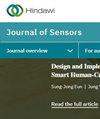Implementation and Comparison of Wearable Exoskeleton Arm Design with Fuzzy Logic and Machine Learning Control
IF 1.1
4区 工程技术
Q3 ENGINEERING, ELECTRICAL & ELECTRONIC
引用次数: 0
Abstract
In this study, a wearable exoskeleton arm was designed and controlled with different control methods to help people with muscle disorders in their arms and support treatment. The developed robot arm was transferred to Simulink software with the Simmechanics application. Two electromyography (EMG) muscle sensors and the ADXL335 position and acceleration sensors attach to the human arm’s biceps and triceps muscle areas. As the human moved the arm, data were obtained from the EMG muscle sensors and the ADXL335 position and acceleration sensor. The received data were first trained with the fuzzy logic algorithm. The same data were then trained with machine learning algorithms in Simulink software. It has been determined that the best result is the quadratic support vector machine (SVM) algorithm. The fuzzy logic algorithm trained with the PID controller block and the received sensor data have been added to the degrees of freedom regions that will enable rotation in the block diagram of the previously exported system. Later, the fuzzy logic block was removed and the machine learning algorithm, the quadratic SVM algorithm, was added. The designed system was operated with two different control systems, and the control algorithm closest to the human arm movement was determined. In addition, each part of the system, whose design was prepared, was removed and assembled separately with a 3D printer. ESP32 microcontroller development board was used to control the system, and it was run in real-time with EMG muscle sensors and position sensors.利用模糊逻辑和机器学习控制实现和比较可穿戴外骨骼手臂设计
本研究设计了一种可穿戴外骨骼机械臂,并采用不同的控制方法对其进行控制,以帮助手臂肌肉有障碍的人并支持治疗。开发的机械臂通过 Simmechanics 应用程序转移到 Simulink 软件中。两个肌电图(EMG)肌肉传感器和 ADXL335 位置与加速度传感器分别安装在人体手臂的肱二头肌和肱三头肌部位。当人移动手臂时,EMG 肌肉传感器和 ADXL335 位置与加速度传感器会获取数据。首先用模糊逻辑算法对接收到的数据进行训练。然后用 Simulink 软件中的机器学习算法训练相同的数据。结果表明,二次支持向量机(SVM)算法效果最佳。使用 PID 控制器块训练的模糊逻辑算法和接收到的传感器数据已被添加到自由度区域,从而可以在先前导出的系统框图中进行旋转。之后,模糊逻辑块被移除,并添加了机器学习算法,即二次 SVM 算法。设计的系统通过两种不同的控制系统运行,并确定了最接近人类手臂运动的控制算法。此外,还将设计好的系统各部分拆卸下来,用 3D 打印机分别组装。使用 ESP32 微控制器开发板控制该系统,并通过 EMG 肌肉传感器和位置传感器实时运行。
本文章由计算机程序翻译,如有差异,请以英文原文为准。
求助全文
约1分钟内获得全文
求助全文
来源期刊

Journal of Sensors
ENGINEERING, ELECTRICAL & ELECTRONIC-INSTRUMENTS & INSTRUMENTATION
CiteScore
4.10
自引率
5.30%
发文量
833
审稿时长
18 weeks
期刊介绍:
Journal of Sensors publishes papers related to all aspects of sensors, from their theory and design, to the applications of complete sensing devices. All classes of sensor are covered, including acoustic, biological, chemical, electronic, electromagnetic (including optical), mechanical, proximity, and thermal. Submissions relating to wearable, implantable, and remote sensing devices are encouraged.
Envisaged applications include, but are not limited to:
-Medical, healthcare, and lifestyle monitoring
-Environmental and atmospheric monitoring
-Sensing for engineering, manufacturing and processing industries
-Transportation, navigation, and geolocation
-Vision, perception, and sensing for robots and UAVs
The journal welcomes articles that, as well as the sensor technology itself, consider the practical aspects of modern sensor implementation, such as networking, communications, signal processing, and data management.
As well as original research, the Journal of Sensors also publishes focused review articles that examine the state of the art, identify emerging trends, and suggest future directions for developing fields.
 求助内容:
求助内容: 应助结果提醒方式:
应助结果提醒方式:


